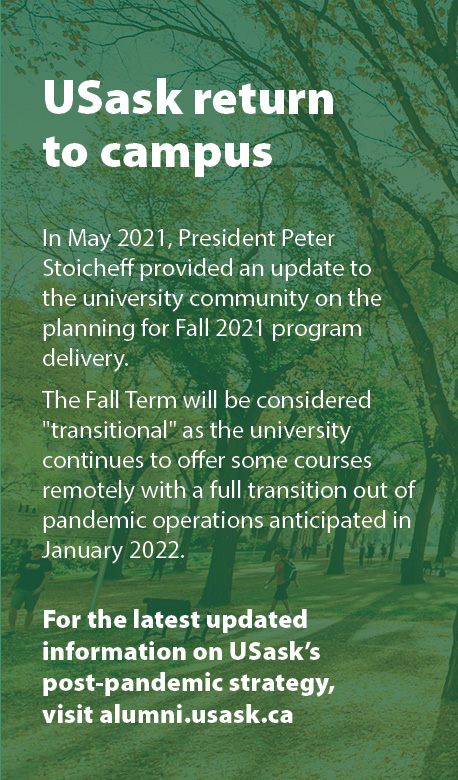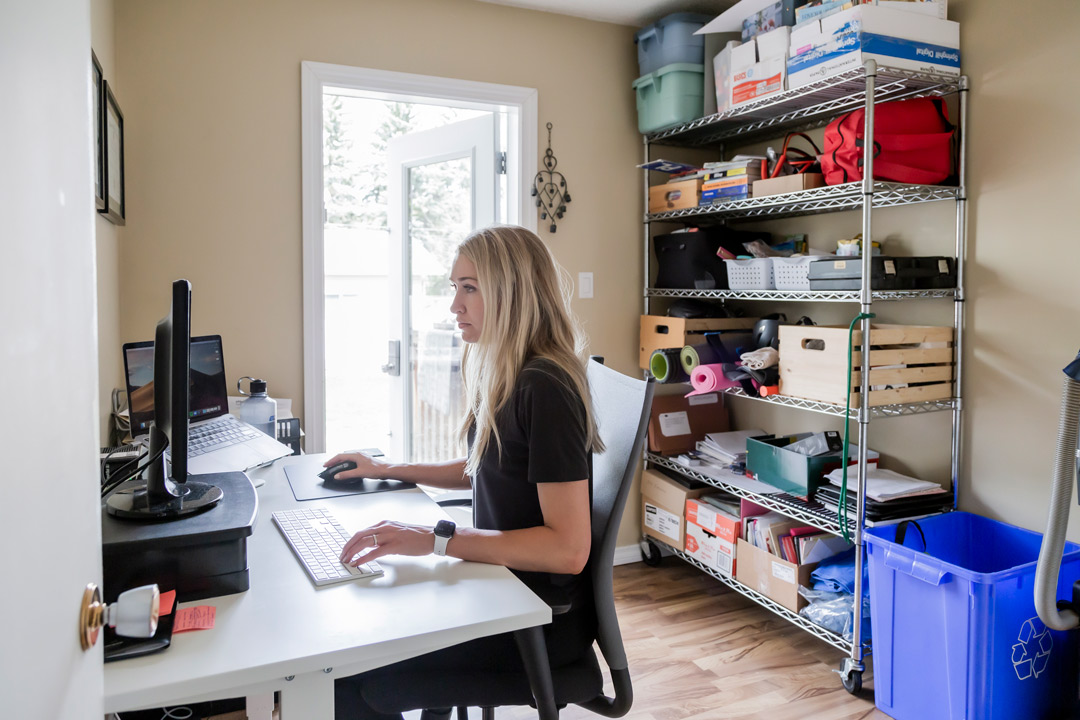Working at a distance, innovating together
As many companies and organizations closed their doors in March 2020, a large portion of the population headed from the boardroom to their home offices, including faculty and staff at USask.
By Henry-Tye GlazebrookLike many alumni, working from a home office has given Mckenize Hunter (BCOMM’15) more quality time with her furry family members. Photography: Carey Shaw
But how do you replicate organic small talk that no longer happens because people aren’t passing each other in the kitchen or the hallway? How do you get new team members who’ve just been hired to feel connected and part of a team?
Despite the drastic shift in everyday life, USask faculty, staff, students and alumni have persevered in this new world of work and learning.
If you take a straw poll of your friends and family, you’ll likely hear a lot of similar answers for when the COVID-19 pandemic truly started to feel real.
They might think about it for a moment, but eventually a good number will furrow their brow or run a hand through their hair and recall a day in mid-March 2020, when they left the office or school at the end of the day and simply, exhaustingly, didn’t go back.
But for Nancy Turner, director of Teaching and Learning at the University of Saskatchewan, reality had already started to set in as far back as 2019 — when news reports of a novel coronavirus strain were first carried across the Pacific, and USask leaders started meeting to discuss what would need to happen if and when that virus landed on their doorstep.
“I don’t think anyone would have ever predicted that we would end up where we’ve ended up, but certainly those conversations were happening,” Turner said. “I think it was in February that I was asked for the first time if I felt we could transition quickly, if needed, to remote delivery.
“I immediately said yes, we could. I believed we could do it if we had to,” said Turner.
These exact discussions became a mainstay of work culture worldwide, as offices of all sizes and scopes found it suddenly critical that team members immediately shift to a remote working model. The alternative — going against health and safety regulations, sure, but also risking the spread of COVID-19 among staff, their families, and the larger community — was too dire to consider.
Those first few weeks for Turner were a whirlwind of high priorities and shifting stressors for the university community — not just getting people safely off campus, but also ensuring faculty and students had the technology necessary to succeed remotely, helping those same folks navigate new means of teaching and learning, and doing all of this in the midst of a campus season normally reserved for exams and other academic year-end send-offs.
“We were about a week and a half, two weeks at the most, from the end of the term when we made that change,” Turner said. “Really, we were just trying to get to the finish line, ensuring students were taught what was essential, and then think about how we were going to do our assessments in a remote context.”
When exams were over, and the public became more accustomed to life at home, masks in public and other new mainstays of life, USask leadership shifted their focus towards the 2020 fall semester.
Part of this process involved developing frameworks to determine which classes — those that required hands-on clinical training, for example — would necessitate limited on-campus instruction. Another was to enhance available technology to ensure cohesive learning.
One key focus, Turner said, was working with faculty to make sure people weren’t just comfortable but emboldened to leave behind, indefinitely, classrooms that often felt like home to enrich minds through webcams and keyboards.
“Many of them had never taught in this way before, and that meant they invested a lot in preparation of resources that could be accessed in an online format — really rethinking the way in which teaching and learning was approached in this new context,” Turner said.
“You can’t just take what would have happened in a face-to-face context and expect it’s going to work in an online environment. It’s a very different teaching and learning practice.”
Instrumental to ensuring a successful remote-work adaptation was understanding how that switch would affect the larger campus infrastructure — buildings emptied of their usual flow of people, sourcing new networking tools, and assuring crucial pillars like human resources supports and administrative financing flowed smoothly from one working model to the next.
At the centre of this transformation was Cheryl Carver, associate vice-president People and Resources and one of about 50 people making up the university’s cross-organization Pandemic Response Team.

As part of the Pandemic Response Team and in collaboration with senior leadership, Carver helped develop a priority framework to pursue a fast, but also steady, pivot to remote work: securing the institution’s financial safety during a global pandemic, procuring essential items such as facemasks to bolster safety for on-site workers and making sure that faculty and staff leaving their campus life behind had the resources they needed.

Mental health support is just one way USask has aided off-campus staff in successfully managing remote work, Carver explained, drawing their own boundaries between where work ends and life begins and helping management understand those distinctions within their teams.
“We’ve done a lot of work with our people leaders providing tools and guidance on what they can do to manage in a remote work environment,” Carver said. “I think empathy and understanding to manage in this more complex environment is going to be a much more important factor that’s looked at in our leaders going forward.”
With vaccinations providing hope for an eventual return to normal, Carver is proud of the way this global pandemic has highlighted just how adaptable even organizations as large as a university can be when push comes to shove.
“Having worked in our organization for many years and seeing the pace of change that we normally experience, given our size and complex governance structure, I think one important lesson is knowing just what’s possible when people come together,” Carver said.
Driving innovation in an institution as large as a university can indeed require great collaboration, but for some smaller groups that change felt as if it arrived nearly as a matter of course.
Working from home
As a business built around the use of web and mobile-based tools to simplify staff scheduling and communication, 7shifts entered the pandemic with many of the strategies necessary for remote work already in-place. As working from home stretched from days into months, Senior Director of People and Culture McKenzie Hunter (BCOMM’15) found herself pleasantly surprised by just how smooth their business continued to operate.

“We had never experienced working remotely on that scale, and it was truthfully the push that we needed to start really adopting it more openly,” Hunter said. “It almost enabled us to have a distributed workforce because, throughout this time, we’ve realized that we never had all that much to worry about. Remote work works.”
More difficult, Hunter said, has been fostering and maintaining an office culture that revolves around the interactions of day-to-day office life.
How do you replicate culture-building small talk that no longer happens when team members no longer see each other in the kitchen or the hallway? How do you get new team members to feel connected.
The answer to these questions and others just like them, involved finding new channels through which their digital-first strengths might lead to stronger interpersonal connection.

“When people are onboarding, sometimes teams will have a window open where they mute and they all silently work away — but then when that new member has a question they just unmute and ask it,” Hunter said. “They can get an answer in real time. That’s been really helpful.”
Even as vaccine rollout has gained momentum and people have started considering what a return to normal might look like, Jean Parchewsky (BA’99) still remembers the desolate feeling that washed over her when she walked into her office for the first time in a post-COVID world.
What would normally be a bustling space — teams corralling their chairs to work together, computer monitors buzzing blue, markers squeaking ideas onto whiteboards — had been hollowed out in only a few short months.
“When I went back and it had gone from an office of about 450 at the time to only a handful of people, it was very eerie,” said Parchewsky, VP of People Operations for Vendasta Technologies, Inc. “There were even decorations on the wall from Christmas still and things left from employees that were now on empty desks.
“It felt like the light of the office was gone.”
Similar to 7shifts, Vendasta was already well prepared when stay-at-home orders became mandatory — staff were already working off laptops, meeting virtually and fluent with Slack, Google Hangouts and other e-communications platforms.
What complicated things was juggling a global pandemic with one of the most critical moments in company history.
“We had just received an investment of $40 million — it was the largest investment for a tech company in the Prairie provinces — and so we were about to accelerate our growth,” she said.
“It was a challenging and exciting time. We were trying to onboard and bring people into the company when we were also learning how to be fully remote and to train people who were fully remote.”
The balance came in finding solutions that suited each staff member individually. For some that meant fully remote, for others a balance between working at home and coming back to their desk among a small crew that could share the space while adhering to Saskatchewan Health Authority guidelines.
In one instance, it even meant recruiting eight new employees from the other side of the globe, during a worldwide pandemic, and who would be leaving behind a country among those most devastated by COVID-19.
“We had hired eight people from Brazil, and we were able to still bring them through Saskatchewan Immigrant Nomination Program.
“They flew in, they quarantined, and they were able to still move to Canada and bring their families with them.”
The COVID-19 pandemic is the boulder in the stream that’s diverted nearly every aspect of life, requiring time, energy, and resources to embrace the inevitable change rippling outward from its arrival.
But if you ask Turner, it’s taken resilience more than anything else.
“Don’t get me wrong, there have been times in this pandemic when I — like anyone — have felt overwhelmed by all this,” she said. “It feels like you’re trying to run a race with absolutely no idea of what the terrain is or exactly where you’re headed. You’re just taking it one step at a time, going as fast as you possibly can and hoping that the next step doesn’t trip you up.
“I know that we weren’t alone in that feeling.”


